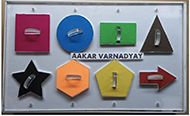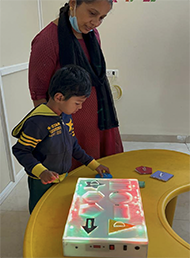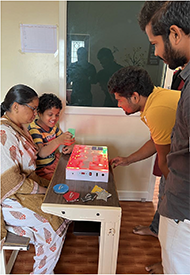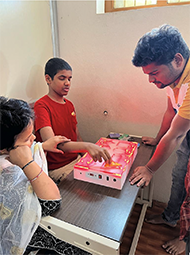Devasani Praneeth*, Rohith Sirpa*, H Sujana*, Pandurang Mirajkar*, Kavali Sai Teja*
* Assistive Technology Lab, B V Raju Institute of Technology, Narsapur, India
INTRODUCTION
Autism Spectrum Disorder (ASD) is a developmental disorder that affects social communication and interaction, as well as behavior and sensory processing. According to the Centers for Disease Control and Prevention (CDC), about one in 54 children in the United States has ASD. Children with ASD often have difficulties in various aspects of learning, including recognizing shapes and colors. This affects a person's behavior, speech, and social interactions is autism, commonly known as autism spectrum disorder (ASD). Because it is a spectrum disease, each person will experience the symptoms and severity of the condition differently. Having trouble communicating both verbally and nonverbally, having trouble interacting with others, engaging in repetitive activities or routines, and having a narrow range of interests are some frequent signs of autism
Recognizing shapes and colors is a critical skill for children with ASD, as it helps them in their daily routines and interactions with the environment. However, traditional teaching methods may not be effective for children with ASD, as they have different learning styles and preferences. Therefore, there is a growing need to develop and implement innovative learning devices that can cater to the unique learning needs of children with ASD.
In recent years, technology has been increasingly used to develop assistive devices for children with ASD. These devices offer a more engaging and interactive way of learning that can help children with ASD to better understand and remember concepts.
This device is designed to be easy to use and adaptable to the individual needs and preferences of each child. It uses a range of visual and auditory cues to help children with ASD learn and remember shapes and colors, and can be customized to suit different levels of learning. This paper aims to evaluate the effectiveness of this device in teaching shapes and colors to children with ASD. The paper will also discuss the potential benefits and limitations of using technology-based learning devices for children with ASD, and explore future directions for research in this area.
LITERATURE SURVEY
Research has shown that children with autism benefit from early intervention and specialized education programs. Traditional methods of teaching may not be effective for children with autism due to their unique learning styles and preferences. Learning devices, such as tablets, smartphones, and specialized software, can be used to supplement traditional methods and provide a more engaging and interactive learning experience.
The study by Peter Francis et al. demonstrates how new technologies are beneficial in enhancing the learning methods for autistic people and how different it is to incorporate people with autism in the design process so that learning gadgets may be created in the most user-centric way possible [1]. Several existing educational tools and mobile have drawbacks, such as the fact that they are not portable and contain numerous circuits within, and some autistic children may not find the mobile apps appealing[2][3]. The names of items can be memorised using a device developed by Mónica A. Carreo-León et al. that uses radio frequency identification, however it may only be useful for a limited number of activities. [4]. Á. C. Júnior mentioned in their study about the alternative communication devices for autism children and also how can they be used as learning devices [5]. A study by Odom et al. found that technology-based interventions, such as video modeling and virtual reality, can be effective in promoting social communication and play skills in children with autism [6]. Another study by Moore et al. evaluated the effectiveness of a tablet-based app that used visual supports and prompting to teach self-care skills to children with autism [7]. In addition to improving learning outcomes, learning devices can also help to reduce anxiety and increase motivation and engagement in educational activities for children with autism. A study by Hourcade et al.found that an interactive tabletop game that incorporated social stories and visual supports was effective in increasing the social engagement of children with autism [8].
Despite the potential benefits of learning devices for children with autism, there are also challenges and limitations that need to be addressed. For instance, some children with autism may have sensory sensitivities that make it difficult to use certain types of technology. Furthermore, the use of technology may not be appropriate for all children with autism, and it is important to consider individual needs and preferences when developing and implementing learning devices.
METHODOLOGY

This device is a learning aid which helps in learning the labels of basic shapes. Eight Shapes (Arrow, Circle, Rectangle, Square, Pentagon, Hexagon, Star, Triangle) and eight colour (Red, green purple, Blue) as shown in Figure 2. There are two modes one is for learning shape and other is for learning colours . These shapes or colours need to be identified using this device by the autistic children and need to arrange the given blocks according to the shapes and colour on the device . Every correct arrangement is indicated by changing the LED colour from red to green and gives corresponding colour or shape voice output.

The female side of the every shape has two pins, and the male side of the shape contains the aluminum foil, When the right block fits in the right shape, the two pins are electrically connected via an aluminum foil, then the microcontroller will be triggered and gives corresponding voice output and an LED to change from red to green, which attracts the children with autism and indicates that the task is done correctly.
CASE STUDY

A pilot study was conducted autistic Children at a special education school in Hyderabad, India as shown in Figure 3, Figure 4, Figure 5 with different age groups to evaluate the effectiveness of the device in enhancing learning and communication skills in children with autism with the different age groups. The children were very enthusiastic and interested to learn and from the device as it was seeking their attention through the LED's and voice output. compared to the existing static learning aid this device is helping to learn the autistic children interactively in short time
RESULTS
S. No. |
Age Group (Years) |
Time taken to learn on Static Existing Learning Aid |
Time taken to learn on AAKAR VARNADYAY |
1 |
5 to 8 |
4-5 Weeks |
3-4 Weeks |
2 |
8 to 10 |
3-4 Weeks |
1-2 Weeks |
3 |
10 to 15 |
2-3 Weeks |
1-2 Weeks |

The development of a this learning device for children with autism has shown promising results in improving their learning outcomes and increasing their engagement in educational activities as shown in the Figure 6. The device utilizes interactive technology and tailored educational content to cater to the unique needs and learning styles of children with autism.

Through this device , we have identified the challenges and requirements of designing an effective learning device for children with autism, including sensory sensitivities, communication barriers, and individual learning preferences. We have also highlighted the importance of involving parents, educators, and therapists in the development and implementation of the device to ensure its effectiveness and usability.
CONCULSION

This device have the potential to significantly enhance the educational experiences and outcomes of children with autism. According to the study done explains the effectiveness of technology-based interventions in promoting social communication, play skills, and self-care skills in children with autism. However, further research is needed to evaluate the long-term benefits and limitations of this devices for children with autism, and to develop more individualized and inclusive learning devices that can cater to the unique needs and preferences of each child.
Through this project, we have identified the challenges and requirements of designing an effective learning device for children with autism, including sensory sensitivities, communication barriers, and individual learning preferences. We have also highlighted the importance of involving parents, educators, and therapists in the development and implementation of the device to ensure its effectiveness and usability.
REFERENCES
[1] Peter Francis BIS (Hons), David Mellor PhD & Lucy Firth PhD (2009) Techniques and Recommendations for the Inclusion of Users with Autism in the Design of Assistive Technologies, Assistive Technology
[2] T. Zaki et al., "Towards developing a learning tool for children with autism," 2017 6th International Conference on Informatics, Electronics and Vision & 2017 7th International Symposium in Computational Medical and Health Technology (ICIEV-ISCMHT), Himeji, Japan, 2017.
[3] Emir Husni, Budianingsih, Mobile Applications BIUTIS: Let's Study Vocabulary Learning as a Media for Children with Autism, Procedia Technology Volume 11, 2013.
[4] M. A. Carreño-León, J. Andrés Sandoval-Bringas, I. D. Encinas, R. Cosio Castro, I. E. Cota and A. Leyva Carrillo, "Design of an interactive system of tangible interfaces to support learning in children with autism," 2020 3rd International Conference of Inclusive Technology and Education (CONTIE), Baja California Sur, Mexico, 2020
[5] Á. C. Júnior, "Assistive Technology Device for People with Autism," 2020 IEEE Congreso Bienal de Argentina (ARGENCON), Resistencia, Argentina, 2020.
[6] Odom, S.L., Thompson, J.L., Hedges, S. et al. Technology-Aided Interventions and Instruction for Adolescents with Autism Spectrum Disorder. J Autism Dev Disord 45, 3805–3819 (2015).
[7] Moore, G. F., Evans, R. E., Hawkins, J., Littlecott, H., Melendez-Torres, G. J., Bonell, C (2019).
[8] Juan Pablo Hourcade, Stacy R. Williams, Ellen A. Miller, Kelsey E. Huebner, and Lucas J. Liang. 2013. Evaluation of tablet apps to encourage social interaction in children with autism spectrum disorders. Association for Computing Machinery, New York, NY, USA,